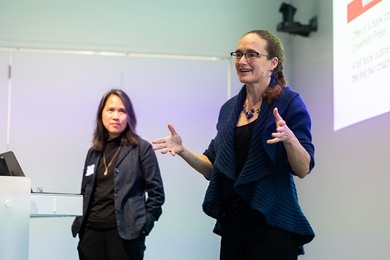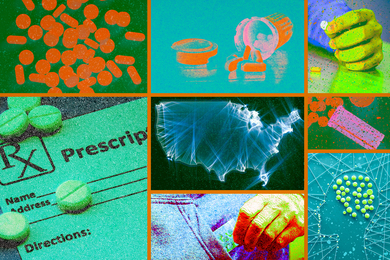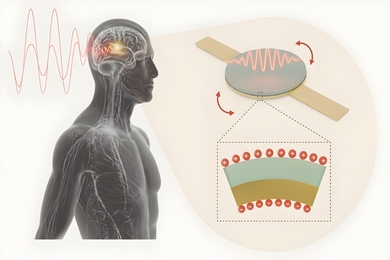For more than two decades, MIT Professor Michael F. Rubner has been discovering new ways to build up layer-by-layer water-based, non-toxic polymers with special properties such as coatings with the ability to prevent fog and frost from forming and cellular patches, or “backpacks,” that could boost the immune system.
“We do a lot of fundamental work, so we seek to understand how molecules adsorb out of aqueous solutions onto surfaces … then from that understanding, all these applications start to pop out,” says Rubner, the TDK Professor of Polymer Materials Science and Engineering. Early studies focused on how pH and charge density affect the way charged polymers and particles adhere to surfaces.
Rubner’s decade-plus partnership with MIT Department of Chemical Engineering Professor Robert E. Cohen has produced more than 60 scientific papers. “We started doing joint research through [Center for Materials Science and Engineering] funding. Bob had certain unique capabilities in nanoreactor technology and block co-polymer technology, and I was developing this layer-by-layer field, and we decided that there was a unique opportunity to bring those two worlds together,” Rubner recalls.
As they merged their research, the Rubner group and Cohen group held joint meetings. “It’s a beautiful illustration of how MIT faculty can work together and collaborate, and do things that are significantly better than what the individual faculty members could do. That’s really the mission of CMSE, to bring people together that otherwise wouldn’t come together and have great things happen,” Rubner explains.
Directing CMSE
Rubner also directs MIT’s Center for Materials Science and Engineering (CMSE), which fosters interdisciplinary research and offers a variety of educational outreach projects, including jointly hosting the annual Summer Scholars program with the Materials Processing Center.
CMSE sponsors researchers at levels from seed funding through Interdisciplinary Research Groups (IRG). CMSE is funded by the National Science Foundation under its Materials Research Science and Engineering Center (MRSEC) program. About 1,200 different researchers use CMSE shared experimental facilities each year. Educational programs bring area high school teachers to campus for hands-on lab experience each summer while other programs reach students from kindergarten through high school.
Convening practitioners
Rubner was co-organizer with Stevens Institute of Technology Associate Professor of Chemistry Svetlana Sukhishvili of the Layer-by-Layer (LbL) Assemblies: Science and Technology Conference in Hoboken, N.J., June 23-25.
“Professor Rubner has made contributions to science and technology of polymer coatings that seem, to me, quite unparalleled. Michael’s pioneering work on hydrogen-bonded, weak polyelectrolyte and polyelectrolyte-nanoparticle layer-by-layer (LbL) coatings has lead to the development of new types of superhydrophobic, superhydrophilic, and antireflective coatings,” Sukhishvili says. “Another novel direction pioneered by Rubner’s group is the use of the LbL technology to tag live cells. Specifically, their group has succeeded in attaching functional LbL-based backpacks to immune cells. This work opens many opportunities in using the LbL-modified immune cells in cancer therapy. More recently, the Rubner/Cohen group has reported on LbL films that respond very differently to liquid water or water vapor. This recent exciting work has lead to the development of new types of antifogging coatings with frost-resisting capabilities.”
More than 100 people participated in the LbL conference at Stevens. “The field is still alive and doing well,” Rubner says.
Interdisciplinary collaborations
MIT professors John Joannopoulos, Yoel Fink and Edwin L. "Ned" Thomas (now dean of the Brown School of Engineering at Rice University) began their quest for a perfect mirror years ago with CMSE seed funding, Rubner says. They eventually developed omnidirectional reflectors, leading to the spinoff company OmniGuide, which makes minimally invasive laser surgical equipment. “They evolved from seed funding into an IRG, and that’s been a very successful venture,” Rubner says.
His own collaboration with Cohen over the past dozen years follows the collaborative model, Rubner explains. The pair jointly supervise about three-quarters of their undergraduates, graduate students and postdocs. The groups ran as high as two dozen members over the years but contracted with the Great Recession in 2008 and recently was made up of about a dozen. The groups graduated about half their members this year, so they are looking to grow again.
“We run it like one gigantic shared facility,” Rubner says of the two labs. “Basically all of his group and all of my group come together on a weekly basis to discuss our research, and make presentations,” he says. “Even folks who are not directly supervised by us as a team are still involved.”
Group members have access to both Cohen’s and Rubner’s labs. “When we recruit new students or postdocs, we say, ‘By the way, you’re going to have two bosses. You might find that a little intimidating, but on the other hand, you’re going to have twice the resources,” Rubner says.
Controlling water adhesion
Rubner’s early research focused on how the pH of a solution influences the way polymers adsorb onto surfaces from aqueous (water-based) solutions — in particular, on charged polymers for which the charge density of the polymers varies with changes in pH. “You change the pH of the solution, you get a different charge density, a different way the polymer adsorbs onto the surface. I devoted a lot of time to understanding that from a fundamental standpoint,” Rubner explains.
“Pretty much everything we do since then in all these applications that we’ve been talking about including backpacks and anti-fogging and Zwitter wettability is based on the fundamental knowledge we gained from trying to answer that very simple question: How does pH of a water-solution influence the way macromolecules adsorb onto surfaces?” he says.
The group developed thin films to control water on surfaces, mimicking the way lotus and other plants shed water from their leaves. “We published a paper many years back on superhydrophobicity. Superhydrophobic surfaces, where water droplets just roll off the surface, provide a self-cleaning capability,” Rubner says. One ACS Nano Letters paper from 2004, "Stable Superhydrophobic Coatings from Polyelectrolyte Multilayers" has been cited by other researchers nearly 500 times.
“That started us thinking about what else can we do in this area where we control surface chemistry, structure, and topology to create interesting effects and control the way water interacts with surfaces in novel ways,” Rubner explains. The next target was understanding superhydrophilic surfaces on which water immediately spreads. “The advantage of superhydrophilic surfaces is that they can prevent fogging from occurring,” Rubner says.
“Fogging is the condensation of microscopic droplets of water on the surface that scatter light,” he explains. “That’s why you can’t see through fog. If you spread that water into a sheet, the water’s still there. You can’t stop water from condensing onto a surface under certain conditions, but if you spread it into a sheet, you can’t see it. It’s transparent; it’s like a sheet of glass.”
Recognizing the anti-fogging capability of superhydrophilic coatings, Rubner, Cohen, and colleagues published several papers, including “Durable Antifog Films from Layer-by-Layer Molecularly Blended Hydrophilic Polysaccharides,” in the American Chemical Society publication Langmuir in December 2010. The work demonstrated that polymer-based polysaccharide coatings were durable and resisted fogging. The researchers received several U.S. patents, and mainstream media from Canada to New Zealand reported on their anti-fog coatings.
Despite the positive results, the question kept coming up: What happens if the temperature at the surface is below freezing and the water freezes? SWhen water freezes, it’s no longer transparent; it turns into frost,” Rubner explains. “So we said, ‘Hmm, that’s interesting. That means you really can’t use these coatings under conditions that your lenses (for example) are below the freezing point of water or if they drop below the freezing point of water.’ So they were anti-fogging, but they weren’t anti-frost.” The group then turned to addressing that question.
“We changed our formulation and developed a system that sucks up the water like a sponge, but the water that enters the coating is in what is called a non-freezing state. It’s hydrogen-bonded to the (polymer) matrix that we created,” Rubner says. “As a result, there is either a strong melting point depression or no melting point at all. … If the water stays strongly interacting with our matrix, there is no water-to-water contact, and whatever water gets into the film — and there is a large amount of it — can’t freeze.”
Distinctly different effects
While the new formulation solved the freezing issue by absorbing water vapor, the researchers were able to design coatings that simultaneously appear to be water resistant, thus combining both water-spreading resistance and water-absorbing properties in a single coating. They call this new phenomenon “Zwitter wettability.”
“Zwitter wettability means it has at the same time two distinctly different effects,” Rubner explains. “It’s hydrophobic to water droplets but very hydrophilic to water vapor, meaning water molecules enter very quickly into the coating, into this non-freezing state, but if you put a drop of water onto it, it behaves like a Teflon surface.”
The results were published in the ACS Nano article, “Zwitter-Wettability and Antifogging Coatings with Frost-Resisting Capabilities,” in January 2013. One potential application of the Zwitter-wettability coatings is the inside of freezer doors at grocery stores. “There is capacity limit to any coating we create, but in that application it’s perfect, because you open the door, we suck up the water, we prevent if from freezing. You close the door, the curtain of air is there; it just removes the water out of the coating. Equilibrium forces it out again. So you can do that many, many times, and you’ll never see frost,” Rubner explains.
Commercialization is still pending. “There’s interest, and we’re collaborating with a company to move forward on trying to develop this into a real technology,” he says.
“We can take our coatings, expose them to water vapor so they suck water up like a sponge, and we can determine how much water they picked up. It’s a very large amount; the coating swells. If we then freeze it, without any excess water on top, incubate it at a low enough temperature that water would normally freeze – it stays completely clear even though it’s loaded with water,” Rubner says.
Rubner was named a 2014 Materials Research Society Fellow "For pioneering research in layer-by-layer assembly of functional thin films; inspirational mentoring of two generations of materials scientists; and visionary leadership in the materials community worldwide."
Molecular backpacks
Another line of research in the Cohen and Rubner groups is polymer patches for living cells, which they call “backpacks.” Created with layer-by-layer processing, the backpacks are a marriage between synthetic materials and the living natural world, Rubner says. Joint research with University of California at Santa Barbara chemical engineering Professor Samir Mitragotri is testing in rats how effectively immune cells with added backpacks can carry drugs to disease sites. “I think it’s a very exciting opportunity to use the backpacks for drug delivery,” Mitragotri says.
“The idea is we want to use the body’s own cells to deliver drugs to specific tissues within the body. The drugs by themselves have a very difficult time reaching many organs in the body,” Mitragotri explains. For instance, cancer may be highly localized, but injecting anti-cancer drugs into the blood spreads the drugs throughout the body rather than targeting the disease site. Additionally, drugs injected into the blood may not be able to penetrate certain areas of the brain. But natural immune cells can access parts of the body that synthetic materials cannot, he says. Hitchhiking on those immune cells may provide a new path for drug delivery.
“We rely on the immune cells to carry drugs to specific tissues. We expect this to be broadly applicable because immune cells access different tissues in various diseases. This can be a broad strategy that can be used for treatment of multiple diseases. Backpacks can encapsulate different drugs and can also encapsulate imaging agents, so could potentially be used to image certain sites in the body as well,” Mitragotri says. He expects results to be published soon.
The animal experiments are an outgrowth of Rubner and Cohen’s earlier collaborative work with Professor Darrell Irvine of the departments of Materials Science and Engineering and Biological Engineering, including the 2008 Nano Letters article, “Surface Functionalization of Living Cells with Multilayer Patches.”
“We developed the backpacks and the protocols for attaching them to the cells,” Rubner explains. Techniques they used include the layer-by-layer assembly of the backpacks, docking chemistry for adhering to the living cells and release chemistry for freeing the drugs at the disease site.
Making the switch
Rubner recalls that when he made the decision a little over two decades ago to focus on layer-by-layer assembly, he was working with Langmuir-Blodgett films, a process in which structures of many layers are built up by repeatedly dipping a substrate into a solution in which molecules interact at the interface of air and water, adding a single layer at a time. “I had three $60,000 Langmuir-Blodgett troughs for doing that. When I made the decision to move in LbL, layer-by-layer, I took those three $60,000 Langmuir-Blodgett troughs and pulled them out of my lab in one afternoon. Gave them away. Threw them out. And moved everything into this area, because I thought it was going to be a much more important area than L-B, Langmuir-Blodgett,” Rubner says. Layer-by-layer processes have turned out be very versatile with applications ranging from optics to biological uses. “My original idea that this was going to be important turned out to be true,” Rubner says.












